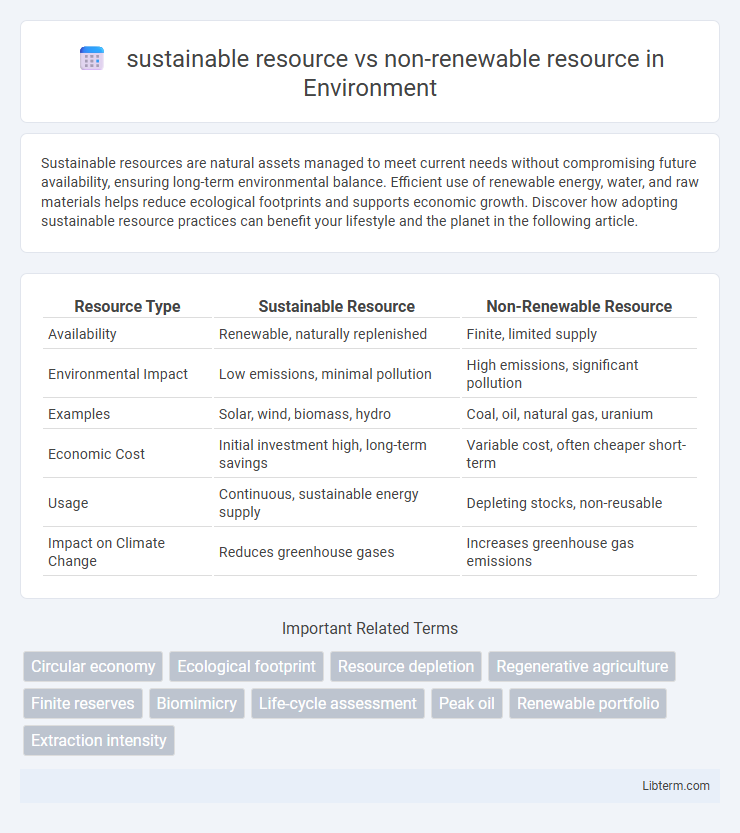Sustainable resources are natural assets managed to meet current needs without compromising future availability, ensuring long-term environmental balance. Efficient use of renewable energy, water, and raw materials helps reduce ecological footprints and supports economic growth. Discover how adopting sustainable resource practices can benefit your lifestyle and the planet in the following article.
Table of Comparison
| Resource Type | Sustainable Resource | Non-Renewable Resource |
|---|---|---|
| Availability | Renewable, naturally replenished | Finite, limited supply |
| Environmental Impact | Low emissions, minimal pollution | High emissions, significant pollution |
| Examples | Solar, wind, biomass, hydro | Coal, oil, natural gas, uranium |
| Economic Cost | Initial investment high, long-term savings | Variable cost, often cheaper short-term |
| Usage | Continuous, sustainable energy supply | Depleting stocks, non-reusable |
| Impact on Climate Change | Reduces greenhouse gases | Increases greenhouse gas emissions |
Introduction to Resource Types: Sustainable vs Non-Renewable
Sustainable resources, such as solar and wind energy, are naturally replenished and maintain ecological balance, making them essential for long-term environmental health. Non-renewable resources, including coal, oil, and natural gas, are finite and deplete over time, leading to environmental degradation and increased carbon emissions. Understanding the distinction between these resource types is crucial for effective natural resource management and sustainable development strategies.
Defining Sustainable Resources
Sustainable resources are natural materials or energy sources that can be replenished naturally at a rate equal to or faster than they are consumed, such as solar energy, wind power, and biomass. Unlike non-renewable resources like coal, oil, and natural gas, which exist in finite quantities and deplete over time, sustainable resources support long-term ecological balance and reduce environmental impact. Efficient management of sustainable resources is crucial for minimizing carbon emissions and preserving biodiversity for future generations.
Characteristics of Non-Renewable Resources
Non-renewable resources, such as coal, oil, and natural gas, are finite and cannot be replenished within a human lifespan, leading to eventual depletion. These resources are characterized by slow natural formation processes, often taking millions of years to develop. Their extraction and consumption contribute significantly to environmental pollution and greenhouse gas emissions, intensifying climate change challenges.
Key Differences Between Sustainable and Non-Renewable Resources
Sustainable resources, such as solar and wind energy, regenerate naturally and maintain ecological balance without depleting over time, while non-renewable resources like coal, oil, and natural gas exist in finite quantities and diminish with usage. The key difference lies in sustainability: sustainable resources support long-term environmental health, whereas non-renewable resources contribute to pollution and resource scarcity. Efficient management of sustainable resources can reduce carbon footprints, contrasting sharply with the environmental impact and economic risks associated with reliance on non-renewable sources.
Environmental Impact of Resource Extraction
Sustainable resource extraction minimizes environmental degradation by promoting renewable materials like solar, wind, and biomass, which reduce greenhouse gas emissions and habitat destruction. Non-renewable resource extraction, such as coal, oil, and natural gas mining, often leads to significant soil erosion, water contamination, and biodiversity loss due to intensive land disruption and toxic byproducts. Implementing sustainable practices helps protect ecosystems and maintain ecological balance, whereas continued reliance on non-renewable resources escalates environmental damage and climate change risks.
Economic Implications of Resource Usage
Sustainable resources, such as solar and wind energy, typically offer long-term economic benefits by reducing dependency on finite resources and stabilizing energy costs through renewability. Non-renewable resources like coal and oil can generate immediate economic gains but often incur hidden costs related to environmental degradation, health impacts, and market volatility. Investing in sustainable resource infrastructure encourages job creation in emerging green industries and supports economic resilience against resource depletion and price fluctuations.
Case Studies: Sustainable Resource Success Stories
Iceland's geothermal energy program showcases the effective use of sustainable resources by harnessing volcanic activity to meet nearly 90% of the country's heating and electricity needs, significantly reducing carbon emissions. Another example is Costa Rica's extensive investment in hydropower, wind, and solar power, enabling the nation to run on nearly 100% renewable energy for several consecutive years. These case studies highlight the pivotal role of sustainable resource management in achieving energy independence and environmental conservation, contrasting sharply with the depletion and pollution associated with non-renewable fossil fuels like coal and oil.
Challenges of Relying on Non-Renewable Resources
Non-renewable resources such as coal, oil, and natural gas present significant challenges including finite availability, environmental degradation, and contribution to climate change through greenhouse gas emissions. Their extraction and usage often result in habitat destruction, pollution, and geopolitical conflicts over dwindling reserves. Reliance on these resources impedes long-term energy security and necessitates urgent transitions to sustainable alternatives like solar, wind, and hydropower.
Future Trends in Resource Management
Sustainable resource management increasingly integrates advanced technologies such as AI-driven analytics and remote sensing to optimize renewable energy use and reduce environmental impact. Future trends emphasize circular economy principles, promoting resource efficiency and waste minimization through recycling and upcycling processes. Non-renewable resource reliance is projected to decline as policy shifts and innovation accelerate the transition to cleaner alternatives and carbon-neutral solutions.
Promoting a Shift Toward Sustainability
Promoting a shift toward sustainability requires prioritizing renewable resources such as solar, wind, and biomass, which replenish naturally and have minimal environmental impact. In contrast, non-renewable resources like coal, oil, and natural gas contribute to pollution and deplete finite reserves, leading to long-term ecological and economic challenges. Transitioning to sustainable resource management enhances energy security, reduces carbon emissions, and supports resilient ecosystems for future generations.
sustainable resource Infographic

 libterm.com
libterm.com